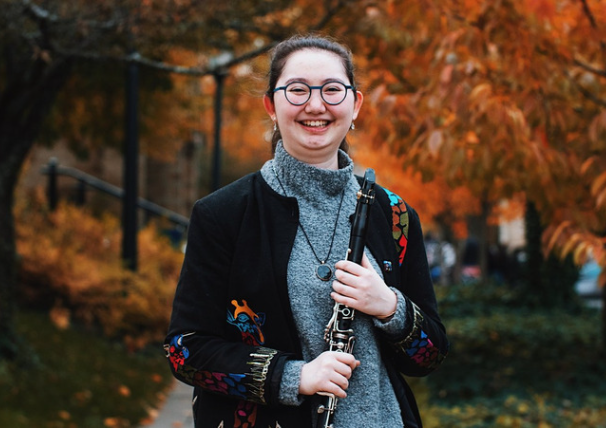Women's History Month: Nikki Pet ’23MM
Meet clarinetist Nikki Pet ’23MM. Nikki earned a bachelor-of-arts degree from Columbia University and was a student in the university’s exchange program with The Juilliard School. In addition to studying the clarinet with Prof. David Shifrin here at YSM, Nikki has been refining her multimedia practice, through which she hopes to make classical music more accessible to the general public. Nikki has created visual elements to accompany performances of such works as Joan Tower’s Wings and Prokofiev’s Peter and the Wolf and earlier this year created an animation to enhance a performance, as part of the Yale Clarinet Celebration organized by Shifrin, of Tower’s Fanfare for the Uncommon Woman No. 5.
Q: Who were the role models who inspired the direction and development of your career?
Undoubtedly, the biggest role model in my life has been my older sister by three years, Kaitlin Pet. In the present day, Kaitlin is my best friend, my close collaborator in music and technology, and (of course) my family. However, as a kid I wanted nothing more than to be exactly like my older sister. Kaitlin has always been smart, talented, and high-achieving. Whatever Kaitlin did, whether it was playing the piano or reading a certain book, I would follow in quick succession. In fact, she had to explicitly prohibit me from picking up her main instrument, the oboe, as my instrument of choice for fourth-grade school band. Of course, I ended up picking the clarinet, the most visually similar instrument available.Though I consciously stopped trying to be my sister’s copycat by high school, she will never stop being my role model and inspiration. Perhaps it was because I so closely followed in her footsteps, but the way we think is very similar and our career interests are very closely aligned, focusing on technology in performance. As a result, we have developed an incredibly rewarding, synergetic working relationship—a relationship that is crucial in realizing the multimedia performances that I create.
Q: You’re working to create more access to classical-music performances through the incorporation of multimedia. How did you develop this interest and why do you feel it’s important?
For much of my childhood I felt pretty apathetic toward classical music. Even after taking up piano and then clarinet as a hobby, it still took many years for me to develop a genuine interest in the genre. To achieve this appreciation, I had to pass a hurdle of comprehension and education in the genre that took numerous years of training to develop—years that few members of the general public are willing to invest. To bridge this gap, bringing classical performances to such novice audiences became a prominent interest. I have tried several techniques to achieve this goal, including verbal introductions and trying to craft a “storyline” with repertoire selection, but nothing ever created as deep an impact as multimedia performance. I first realized this as a junior in undergrad after producing a fully staged performance of Stravinsky’s L’Histoire du Soldat. After the concert, a pre-med friend of mine came up to me and remarked that she never thought she would have liked the Stravinsky by itself, but in the context of a full production the music “just felt right.” This spurred me into further exploring multimedia augmentation—not just adding it as an afterthought but using it to draw out the nuance of performance in a way that is visually explicit and immediately understandable. As I produced more of these multimedia performances, I saw more and more of this type of reaction, audiences being able to pick up on detailed musical nuance as a result of the multimedia, which has only strengthened my conviction to follow this path.
Q: How has your time at Yale helped you develop that creative practice?
Though my earliest conceptions of multimedia performance started before coming to Yale, the vast majority of my experimentation with this medium has happened during my time at the School of Music. I am very grateful to Professor David Shifrin for not only being an amazing teacher of the clarinet, but also a big supporter of my work with multimedia performance. In addition to the vast resources that Yale offers, I have also been incredibly lucky to meet many other students who are willing to collaborate and experiment in this practice with me, which has played a big part in the development of my practice.






